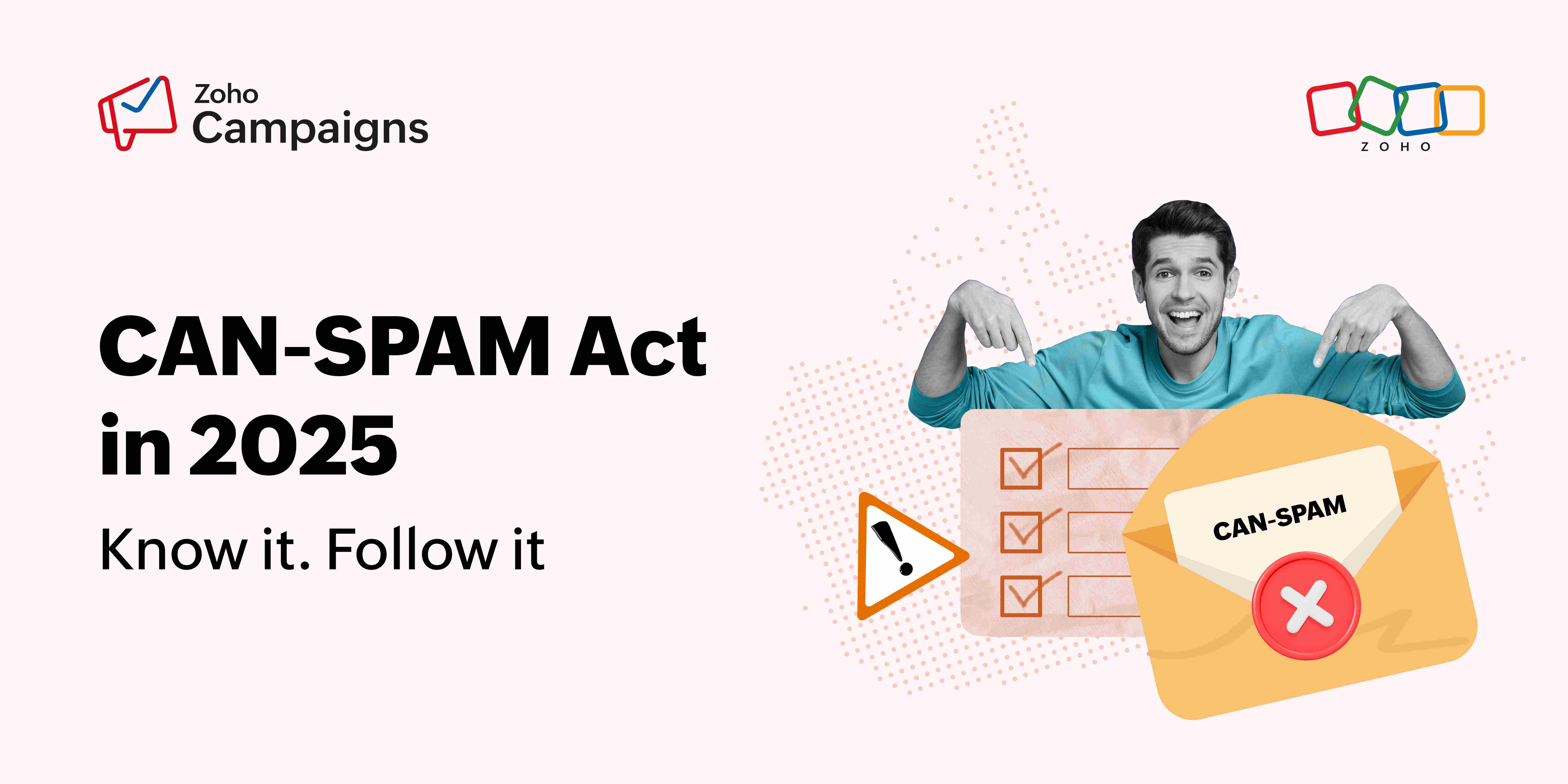- HOME
- Email Marketing
- How to use email marketing effectively for financial services
How to use email marketing effectively for financial services
- Last Updated : August 8, 2024
- 1.1K Views
- 7 Min Read

In its 2023 Global Banking Annual Review, McKinsey has highlighted the emergence of generative AI as a transformative technology that will help improve banks' productivity and reduce their operational costs. In its future outlook, the report says that technological progress will continue to accelerate as customers increasingly become comfortable with and demand technology-driven experiences.
Customers are looking for meaningful experiences that are less intrusive. Effective customer relationship management is a great way for financial institutions to improve satisfaction, loyalty, and retention. Email marketing is one means of interacting with customers regularly, and can help you assess their needs and provide personalized experiences. With the right tools in place, you can also analyze customer data, engage in targeted marketing, and streamline your engagement process.
Email marketing is an effective way to provide timely updates about your services, introduce promotional materials, and provide solutions that work specifically for your customers. Automation can make customer engagement hassle-free and meaningful. In this blog, we'll explore ways banking and financial institutions can use email marketing to engage with their customers effectively.
When does a financial institution use email marketing
Here are a few ways in which banks and financial institutions usually incorporate email marketing in their business.
Welcome emails
Once customers submit their account opening forms and the bank processes them, customers receive emails from the bank confirming the opening of the account and welcoming them aboard.
These set the tone for future email interactions. Apart from confirming account creation, they help customers understand the services the institution provides and essential security information—the first step in long-term relationship management.
Transactional emails
Transactional emails are automated messages triggered by user actions that share essential details related to financial transactions. These include updates about withdrawals and deposits, password resets, payment confirmations, fraud alerts, and account statements. By providing these kinds of communications, financial institutions can enhance customer trust and engagement.
Upselling and cross-selling
An important aspect of relationship management is to nurture conversations such that the bank is able to upsell and cross-sell its products. For this very reason, banks employ dedicated relationship managers for high-net worth customers. Emails help in cross-selling as they provide personalized recommendations and offers to existing customers based on their past behaviors. By analyzing customer data, banks can identify potential needs and suggest relevant products, such as credit cards, loans, or investment services. Targeted email campaigns can inform customers about new products, promotions, and benefits, encouraging them to take advantage of additional services. Here's an example of a mailer sent out by HDFC Mutual Fund about a new fund offering for existing customers.
To make this possible, you need an email service provider that provides detailed analytics that enable you to make sound business decisions. Check out how Zoho Campaigns helps businesses stay up to date with accurate campaign reports. This approach enhances customer engagement, builds loyalty, and increases the bank’s revenue by tapping into the existing customer base with tailored and timely offers.
Educational emails
Financial products require a certain degree of awareness, which requires consistent and patient customer education. Banks stand to benefit from educating their customers in different ways. For example, when customers are aware of the benefits of a particular mutual fund or investment plan, they may choose to invest in it via the bank itself. Banks use email marketing platforms like Zoho Campaigns to send educational emails containing valuable content on topics like financial literacy, investment tips, and savings strategies. A bank might also send newsletters containing advice about budgeting apps, retirement planning, or the benefits of high-yield savings accounts. These emails come with neat designs, clear language, and actionable advice. Personalized subject lines like "Boost your savings today" and clear call-to-action buttons improve engagement.
The above newsletter from NSDL, one of the largest depositories in the world, is a good example of making people aware about the need for digital privacy while performing transactions online.
Promotional emails
The BFSI sector is an extremely competitive one, in which there are constant efforts to present attractive offers and interest rates to customers. Banks use email marketing to offer personalized services and products and to inform clients about new accounts, credit card limits, loans, and special offers. By analyzing customer data, banks can tailor emails to target specific needs and preferences, thereby enhancing engagement. Below is a mailer from Standard Chartered for its credit card customers. This is a seasonal offer they deploy specifically at a time of year when customers are busy filing their returns.
Promotional emails can feature newsletters, exclusive discounts, and limited-time offers designed to encourage customer engagement and loyalty. Banks also use emails to share updates on interest rates and reward programs, which helps them reinforce their brand presence and stay connected with customers. By segmenting their customer base, banks ensure the content they provide is relevant, such as offering student loan tips to recent graduates.
Product updates
The products and services that financial institutions offer change all the time. Sometimes, a change may involve an additional benefit related to an account. Other times, it might relate to a new security feature that has been added to ATM functionality. Email marketing helps a financial institution maintain regular communications with customers, provide updates, share promotional offers, and personalize offers based on their preferences.
This is not only a way to keep customers engaged but also to reinforce brand loyalty. Additionally, email marketing provides valuable insights through metrics like open rates and click-through rates, enabling further refinement of customer strategies. Planning an email marketing campaign for financial institutions involves several strategic steps to ensure compliance, engagement, and effectiveness.
How to plan an email marketing plan for financial services
Define your campaign goals
Identify your primary purpose in using email marketing as a channel. List out all your goals: customer retention, product promotion, brand awareness—whatever it is, be clear about it and prepare your calendar to determine how often you want to send out your emails and what actions trigger each kind. Unlike other kinds of businesses, financial service emails are bound by legal norms that govern the kinds of transactional emails you'll be sending out automatically, so keep these legal requirements in mind as well.
Know your audience
Every bank and financial service provider divides its customer base into portfolios, which are primarily based on parameters like total net worth and investment size. You can also add other criteria based on demographics, behavior, and age to ensure personalized and relevant content.
This also makes email list segmentation an important part of your work. Email list segmentation is the process of segmenting your email contacts into different groups so that you can send customized campaigns that address the specific needs of each group. Check out this article to learn more about how it works.
Ensure compliance
Being in the BFSI sector, you deal with the hard-earned money of thousands of customers. For this reason, there are many legal considerations you need to be aware of before getting into email marketing. It's important that you adhere to financial regulations and data privacy laws (e.g., GDPR, CAN-SPAM, CCPA), and that you ensure all communications are compliant with industry standards. For example, it might be better to use double opt-in methods to ensure subscribers have consented to receive emails. Compliance with privacy regulations and data security is also essential, as it helps build trust while promoting financial products and services.
Content is king
BFSI customers respond best to a nuanced mix of logical and emotional email content. Most customers ignore bank emails because any direct benefit they might derive from them tends to get lost in a maze of unnecessary details or excessive sentimentality. Your emails should demonstrate that you're genuinely interested in your customer, so don't limit yourself to promotional emails, and take the time to educate them. When a customer finds your emails useful in improving their overall understanding of the financial sector in general, they're more likely to reach out to you for all their investment requirements.
Design and layout
Convey your brand's identity through a clean and professional visual design. People mostly check their emails on the go, so it's important to use a responsive design that enables customers to read them easily regardless of the device they're using. Use a responsive email template that's designed specifically to adapt to various screen sizes. This blog explains how exactly you can go about that. Also, did you know that Zoho Campaigns has a huge repository of ready-made templates to choose from? Check out our page to learn more.
Legal disclaimers and disclosures
Legal requirements vary from country to country and locality to locality. In every email, it's mandatory to include disclaimers and disclosures related to the products and services you offer. For example, mutual fund mailers have to be explicit about the inherent market risks mutual funds are subject to, and should recommend that customers read their offer documents carefully.
Sending strategy
A lot of research has gone into identifying the best times for financial institutions to send out their emails, and today there are solutions available in the market to sort out these challenges. Advanced email solutions help you achieve the best open rates by automatically scheduling them to go out at the best times. You can learn more about send time optimization here.
A/B testing
Today's market is extremely competitive and dynamic. Leave enough room for experimentation with subject lines, content formats, CTAs, and sending times to determine what works best for you. Choosing the right email software helps to a great extent. Zoho Campaigns help you increase your conversions by determining which message resonates the most with your audience and when they're most likely to see it. Check this page to learn how it works.
Banking institutions can develop effective email marketing campaigns by keeping these factors in mind. Doing so will help them build trust, engage customers, and drive business growth—all while ensuring regulatory compliance and data security.



